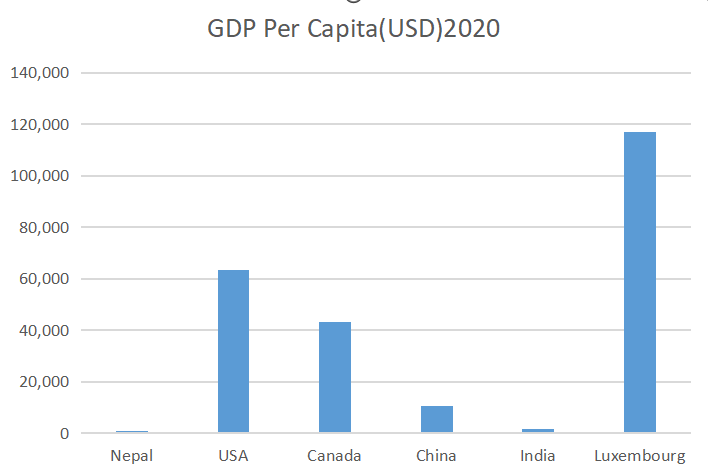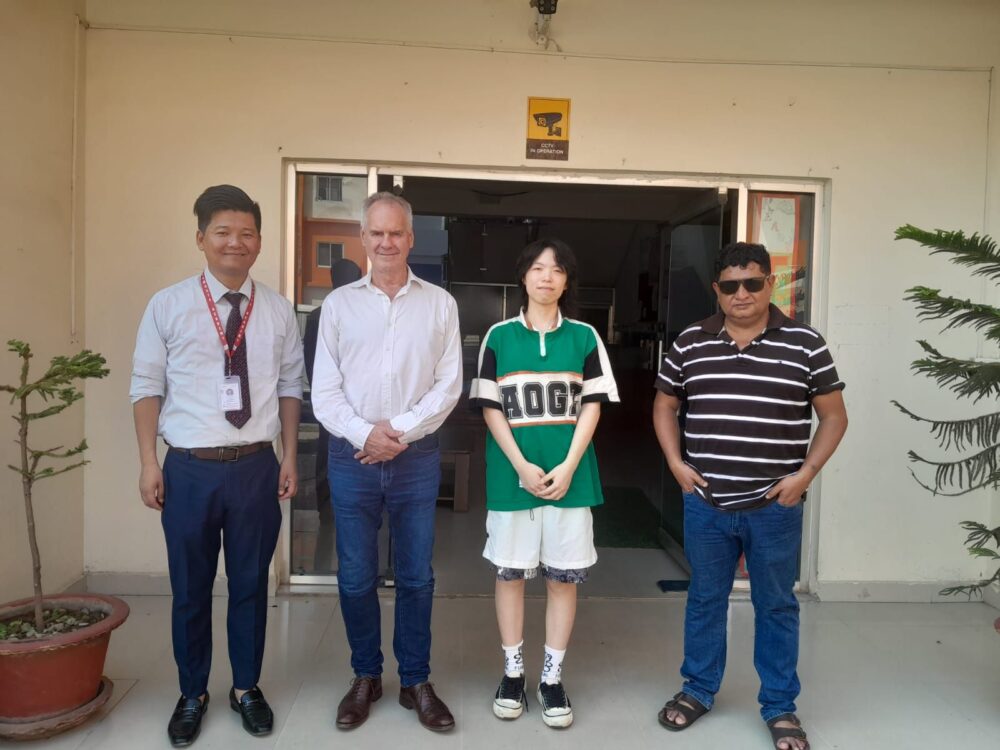Abstract
This research report aims to explore the mutual relationship between the economy and education in less developed countries, with a specific focus on Nepal. Through detailed data analysis, we examine Nepal’s economic development and the government’s investment in education to illustrate the close connection between the two. We find that the low economic status profoundly impacts education, while government investment in education, as well as private-sector investment in education, contributes to elevating the nation’s economic status.
1.Introduction
The interrelationship between the economy and education in less developed countries has long been a subject of interest, as education is considered a key factor in economic growth and societal development. Nepal, as a low-income nation, provides an intriguing case for exploring the connection between economics and education. This report delves into the relationship between Nepal’s economic development and its educational investment through data analysis and case studies.
2.The Current Economic State of Nepal
Nepal is a landlocked country in South Asia with abundant natural resources and tourism potential, yet it has been one of the poorest countries globally for an extended period. According to World Bank data, Nepal’s per capita Gross Domestic Product (GDP) was merely $1,052 in 2020, indicating its economic underdevelopment. In comparison, the United States had a per capita GDP of $63,543, Canada at $43,278, China at $10,484, India at $1,813, and Luxembourg at the world’s highest, $116,921.

3.The Impact of Economic Underdevelopment on Education
The low economic status of Nepal has multifaceted implications on education:
3.1. Education Inequality: Economic hardships hinder families from providing the necessary educational resources for their children, resulting in education inequality. In Nepal, this inequality is manifested as an educational gap between urban and rural areas and unequal access to educational opportunities between affluent and impoverished families.
3.2. School Quality: Low-income regions frequently face inadequate educational infrastructure, insufficient teaching staff, and issues concerning the quality of curricula. These challenges make it harder for students in impoverished areas to access high-quality education.
3.3. Rising Dropout Rates: Economic constraints lead some families to prematurely discontinue their children’s education to support family finances. This poses a hindrance to the children’s future educational and career prospects.
4. Government Investment in Education
Nepal’s public expenditure on education as a percentage of GDP is 4.2%, compared to 6.1% in the United States, 5.2% in Canada, 3.6% in China, 4.5% in India, and 0.3% in Somalia. The nation with the highest percentage is Samoa at 14.7% (2020 data).

Government investment in education is crucial for improving the economic status of less developed countries. In Nepal, the government has undertaken measures to enhance educational levels, including:
4.1. Increased Education Budget: The Nepalese government has consistently increased its education budget year by year to improve school facilities, enhance teacher qualifications, and expand the number of schools, providing more educational resources.
4.2. Educational Reforms: The government has implemented a series of educational reforms aimed at improving education quality, including curriculum enhancements, an education assessment system, and teacher training.
4.3. Enhanced Basic Education Access: The government focuses on providing access to basic education and aims to increase national coverage to ensure that more children have access to primary and secondary education.
5. A Positive Feedback Loop Between Economy and Education
Despite Nepal’s ongoing economic challenges, government investments in education have started yielding results. This demonstrates a positive feedback loop between the economy and education. A more educated population means more individuals entering the labor market, which enhances employment rates. This, in turn, further drives the country’s economic growth, creating more wealth to invest in education, creating a virtuous cycle.
Lumbini, Nepal, holds a special religious and cultural significance as the birthplace of Lord Buddha. However, despite this rich historical and cultural heritage, Lumbini, as well as Nepal as a whole, faces various challenges in terms of its economy and education. Below, we analyze the relationship between the economy and education, using Lumbini as an example.
1. Cultural Tourism in Lumbini: Lumbini, being a sacred Buddhist site, attracts a significant number of cultural tourists. This contributes to the local economy through sources of income such as hotels, restaurants, and tour guide services. However, this industry is primarily limited to specific sectors and hasn’t been able to fully stimulate overall economic development in the city and the region.
2. Economic Development and Education Investment: The educational levels in Lumbini are relatively low, despite the presence of some Buddhist schools and temples offering basic education. However, the government’s investment in education in Lumbini remains limited, resulting in issues related to the quality of education and low coverage. This limitation hampers the city’s economic and social development because high-quality education is crucial for talent development and comprehensive growth.
3. Cultural Preservation and Heritage: Economic development in Lumbini is closely linked to the preservation and propagation of its Buddhist culture. Preserving and passing down the Buddhist cultural heritage is a significant task for the local community, and it can also act as a driving force for cultural tourism.
4. Private Capital Investment in Education:
4.1 Buddhist Schools: Some private Buddhist schools are established in Nepal, catering to domestic and international students. Typically supported by private capital, these schools aim to provide Buddhist education and promote cultural heritage. These schools play an active role in safeguarding Buddhist culture.
4.2 Charity and Donations: Some private capital supports educational initiatives through charity and donations, including offering scholarships, improving school facilities, and enhancing education quality. Such contributions are often driven by faith and cultural heritage.
4.3 Educational Enterprises: Private businesses and entrepreneurs also invest in Nepal’s education sector, offering various learning opportunities and educational services. These businesses can span from kindergarten to higher education at different levels.
4.4 International Collaboration: Some private institutions and international partners are involved in supporting education projects in Nepal to promote educational reform and enhance educational standards. This international collaboration helps introduce global best practices and resources.
4.5 Challenges: Despite the beneficial role of private capital in education, it faces challenges such as ensuring educational quality, extending coverage to rural areas, and enhancing educational equity. Private capital investments often concentrate in urban areas and specific sectors. Therefore, more policies and measures are required to ensure broader access to education and improved quality.
5. In summary, the relationship between the economy and education in Lumbini and Nepal is complex. It necessitates collaborative efforts from governments, the private sector, and the international community to enhance educational standards, stimulate economic growth, and simultaneously safeguard and propagate the precious cultural heritage. This will contribute to more comprehensive economic and social development in Lumbini and the broader context of Nepal.
6. Conclusion
This report underscores the interconnectedness of the economy and education in less developed countries, using Nepal as an illustrative example. The low economic status has profound effects on education, but government investment can help break this cycle. The positive feedback loop between the economy and education offers hope for the nation’s sustainable development. Nevertheless, more efforts are required to ensure more children gain access to high-quality education, helping the country escape economic adversity.
Note: Data and information sources include the World Bank, UNESCO Institute for Statistics, official data from the Nepal government and its education department, as well as relevant research and reports.
— October 1, 2023
Researcher leader: Yilin Wen (China)
Researchers: Yilin Wen (China), Akari Ito (Japan), Ayusha Kafle (Nepal), Hanrui (Singapore)
Counselors: Arun Kumar Kandel (Nepal), Paul Cleves (England), Jigme Sherpa (Nepal), Yuba Kafle (Nepal), Nico Hu (Singapore)
Editor: A.K. (Canada)
Director: Lucia Xinying (Canada)

The author Yilin Wen is second on the right. The left one is principal Jigme Sherpa.


